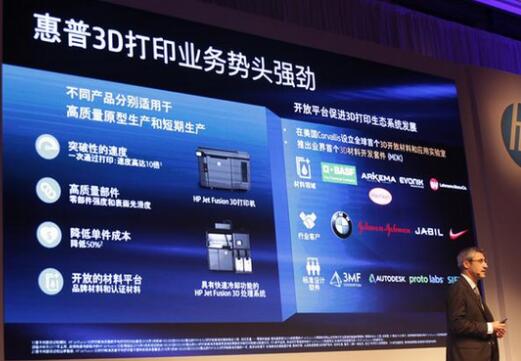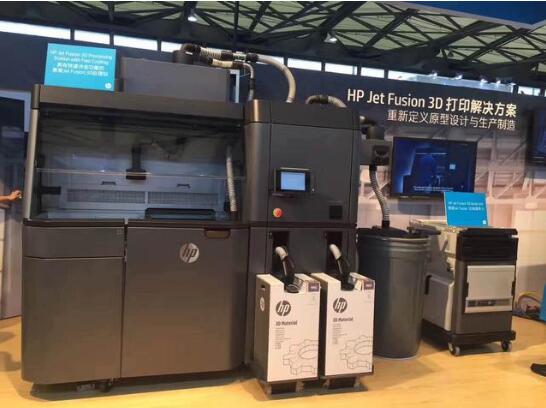In 2014, HP's 3D printing solution was finally born under the expectation of people. In 2017, HP 3D printing solutions came to the Asia-Pacific market and made their debut in Shanghai. Unsurprisingly, Hewlett-Packard Co. said it will expand the scale of its 3D printing business to reshape manufacturing in Greater China. In the context of "Made in China 2025", HP began to lay out its business in Greater China from four aspects. In terms of technology, HP's commercial 3D printing costs were halved and speed increased to 10 times. It is reported that HPMultiJetFusion3D printing solution is already big. Open reservations in China. In terms of channels, HP has established a strong 3D printing dealer base with the first-ever 3D cloud printing, infinite 3D, Shanghai Aurora, 3 tribes, mutual prosperity, Jingwei Xincheng and Wanbao Technology. In terms of materials, HP has attracted a large number of partners to join the HP Open Materials platform. In terms of offline experience, HP will set up 3D printing display and experience centers in Greater China. The cities currently identified are Beijing, Hangzhou, Qingdao, Shanghai and Taipei. At the press conference, HP revealed that the current market value of the 3D printing market is about $6 billion, and it is growing at a rate of 30% per year. The market value of the 3D printing market in 2021 is expected to be about $18 billion. According to the analysis, most of the current 3D printing market belongs to the plastics market (represented by PLA materials), while the technologies and materials represented by HP multi-jet melting technology and nylon are novel and have broad development prospects. It is still hard to fight the iron. In 2014, HP released the HPMultiJetFusion3D printing system. Since then, a new 3D printing technology, multi-jet melting technology, has appeared in front of people. This technology achieves lower printing cost and higher than general 3D printing technology. 10 times the speed, it can be said that this technology is ahead of the world average. However, it does not enter China or even the Asia-Pacific market once it is launched. If 2017 is entered into the Chinese market, then in the past two years, HP has made the entry for HPMultiJetFusion3D printing system. What efforts? RamonPastor (Vice President and General Manager of Hewlett-Packard's MultiJetFusion3D Printing Solutions) said, "HP released the MultiJetFusion technology in 2014. In 2016, we officially launched the product and went public. There are a lot of deployments in the middle because we have to keep up with learning. The process, so the process is relatively slow. Now I plan to launch a production plan to make the product system cover the whole world. China is a very important market for us, so we hope to be fully prepared to enter the Chinese market. In the live experience area, I saw HP's 3D printing system and many materials that can be used for printing, such as PA12 and PA11. At the same time, I also saw the workflow of the HP 3D printing system, which is relatively simple. At the beginning of printing, the system will pre-lay a layer of powder, then sinter, then cool, then lay a layer of powder, and then cycle back and forth, and finally complete the printing process. Familiar with 3D printing technology, different industries have different characteristics for materials. For example, shoes require materials with more elasticity and color, and aerospace requires materials with more hardness and rigidity. In this regard, HP has proposed a number of solutions to propose a full-color printing solution in color. RamonPastor said that the voxel-level concept was mentioned at the press conference, and he hopes to change the color of the finished product by changing the color of the voxel. In the future, it will be applied to a variety of production scenarios. Now, there are many industrial scenes, most of which can still be Satisfy a single color, after printing, you can do some post-processing, such as spraying or plating, to meet the subsequent multi-color requirements. In terms of changing hardness, rigidity, and elasticity, HP has proposed a conversion agent technology that controls the surface texture, wear, and friction of printed products to optimize the strength and stiffness of the finished product. If the technology can be put into production, it is undoubtedly an improvement for the entire 3D printing industry. The 3D printing industry has developed to this day, SLS (selective laser sintering) is gradually being valued by manufacturers, and metal 3D printing has become a key technology in the enterprise market. In terms of industrial applications, 3D printing technology is mainly used in the automotive industry, consumer electronics, healthcare industry, aerospace and other industries. In the interview, RamonPastor said that the traditional 3D printing technology is only suitable for rigorous production or application. For a specific geometry. Now HP can print thousands of parts for volume production. HP's 3D printing technology can be applied in the automotive industry, consumer electronics, healthcare, aerospace and other industries: First, the automotive industry. The amount of mold used in the automotive industry is increasing, and HP will better meet this demand, and the demand for personalized ordering is increasing. Second, consumer electronics, such as printers. One-half of the amount of printers can be produced using 3D printing technology. Third, the healthcare industry, which is one of the goals of 3D printing. The surgical materials we use nowadays are in great need of individualized requirements, which is one of the main areas of application of HP 3D printing technology. Fourth, aerospace. In the aerospace industry, weight is everything. If the designed product has the same function, the lighter the weight, the better, and even save millions of dollars in cost. Finally, RamonPastor mentioned that 3D printing has a lot of charm, which can make printing more efficient, meet individual needs, extend the time limit of parts, and shorten the time to market. Written in the end: from technology to materials, to channels, offline experience stores, HP is fully prepared to enter the Chinese market and even the Asia-Pacific market, if HP can solve the needs of materials and mass production, then 3D printing will certainly What they say will be a good alternative to subverting traditional manufacturing patterns. (Editor) Baking Set,Kids Baking Set,Nonslip Silicone Kids Baking Set,Silicone Baking Set vchomy , https://www.jsvichen.com
